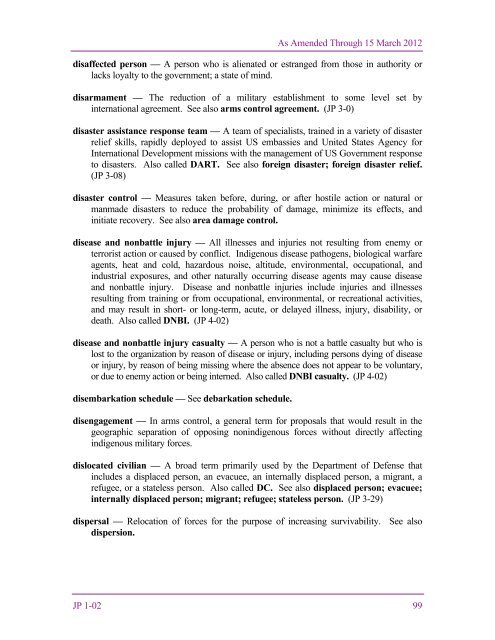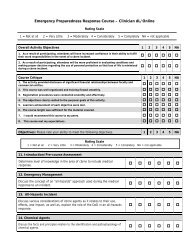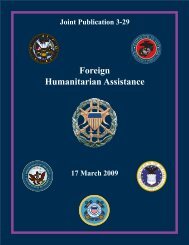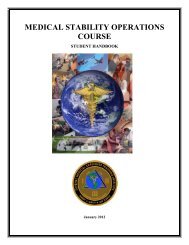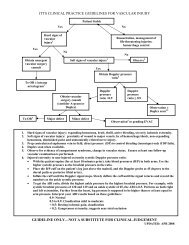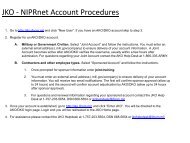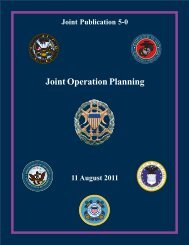- Page 3 and 4:
PREFACE1. ScopeThe Joint Publicatio
- Page 5 and 6:
TABLE OF CONTENTSMAIN BODY ........
- Page 7 and 8:
As Amended Through 15 March 2012Aab
- Page 9 and 10:
As Amended Through 15 March 2012act
- Page 11 and 12:
As Amended Through 15 March 2012adv
- Page 13 and 14:
As Amended Through 15 March 2012age
- Page 15 and 16:
As Amended Through 15 March 2012air
- Page 17 and 18:
As Amended Through 15 March 2012air
- Page 19 and 20:
As Amended Through 15 March 2012uni
- Page 21 and 22:
As Amended Through 15 March 2012air
- Page 23 and 24:
As Amended Through 15 March 2012sig
- Page 25 and 26:
As Amended Through 15 March 2012amm
- Page 27 and 28:
As Amended Through 15 March 2012for
- Page 29 and 30:
As Amended Through 15 March 2012app
- Page 31 and 32:
As Amended Through 15 March 2012pro
- Page 33 and 34:
As Amended Through 15 March 2012tow
- Page 35 and 36:
As Amended Through 15 March 2012val
- Page 37 and 38:
As Amended Through 15 March 2012Bba
- Page 39 and 40:
As Amended Through 15 March 2012bas
- Page 41 and 42:
As Amended Through 15 March 2012bat
- Page 43 and 44:
As Amended Through 15 March 2012bio
- Page 45 and 46:
As Amended Through 15 March 2012bre
- Page 47 and 48:
As Amended Through 15 March 2012Cca
- Page 49 and 50:
As Amended Through 15 March 2012cas
- Page 51 and 52:
As Amended Through 15 March 2012cha
- Page 53 and 54: As Amended Through 15 March 2012che
- Page 55 and 56: As Amended Through 15 March 2012civ
- Page 57 and 58: As Amended Through 15 March 2012cla
- Page 59 and 60: As Amended Through 15 March 2012col
- Page 61 and 62: As Amended Through 15 March 2012com
- Page 63 and 64: As Amended Through 15 March 2012com
- Page 65 and 66: As Amended Through 15 March 2012com
- Page 67 and 68: As Amended Through 15 March 2012def
- Page 69 and 70: As Amended Through 15 March 2012com
- Page 71 and 72: As Amended Through 15 March 2012com
- Page 73 and 74: As Amended Through 15 March 2012con
- Page 75 and 76: As Amended Through 15 March 2012con
- Page 77 and 78: As Amended Through 15 March 2012con
- Page 79 and 80: As Amended Through 15 March 2012con
- Page 81 and 82: As Amended Through 15 March 2012app
- Page 83 and 84: As Amended Through 15 March 2012cou
- Page 85 and 86: As Amended Through 15 March 2012cou
- Page 87 and 88: As Amended Through 15 March 2012pla
- Page 89 and 90: As Amended Through 15 March 2012cus
- Page 91 and 92: As Amended Through 15 March 2012Dda
- Page 93 and 94: As Amended Through 15 March 2012dec
- Page 95 and 96: As Amended Through 15 March 2012aut
- Page 97 and 98: As Amended Through 15 March 2012est
- Page 99 and 100: As Amended Through 15 March 2012Dep
- Page 101 and 102: As Amended Through 15 March 2012dep
- Page 103: As Amended Through 15 March 2012rec
- Page 107 and 108: As Amended Through 15 March 2012dis
- Page 109 and 110: As Amended Through 15 March 2012dro
- Page 111 and 112: As Amended Through 15 March 2012Eea
- Page 113 and 114: As Amended Through 15 March 2012ele
- Page 115 and 116: As Amended Through 15 March 2012ene
- Page 117 and 118: As Amended Through 15 March 2012eme
- Page 119 and 120: As Amended Through 15 March 2012end
- Page 121 and 122: As Amended Through 15 March 2012est
- Page 123 and 124: As Amended Through 15 March 2012exe
- Page 125 and 126: As Amended Through 15 March 2012Ffa
- Page 127 and 128: As Amended Through 15 March 2012fin
- Page 129 and 130: As Amended Through 15 March 2012hea
- Page 131 and 132: As Amended Through 15 March 2012fli
- Page 133 and 134: As Amended Through 15 March 2012for
- Page 135 and 136: As Amended Through 15 March 2012ope
- Page 137 and 138: As Amended Through 15 March 2012eff
- Page 139 and 140: As Amended Through 15 March 2012fus
- Page 141 and 142: As Amended Through 15 March 2012Gga
- Page 143 and 144: As Amended Through 15 March 2012geo
- Page 145 and 146: As Amended Through 15 March 2012glo
- Page 147 and 148: ground fire — Small arms ground-t
- Page 149 and 150: As Amended Through 15 March 2012Hha
- Page 151 and 152: As Amended Through 15 March 2012pop
- Page 153 and 154: As Amended Through 15 March 2012hig
- Page 155 and 156:
As Amended Through 15 March 2012hos
- Page 157 and 158:
As Amended Through 15 March 2012hum
- Page 159 and 160:
As Amended Through 15 March 2012Iid
- Page 161 and 162:
As Amended Through 15 March 2012Ina
- Page 163 and 164:
As Amended Through 15 March 2012Ind
- Page 165 and 166:
As Amended Through 15 March 2012inf
- Page 167 and 168:
As Amended Through 15 March 2012met
- Page 169 and 170:
As Amended Through 15 March 2012mea
- Page 171 and 172:
As Amended Through 15 March 2012int
- Page 173 and 174:
As Amended Through 15 March 2012for
- Page 175 and 176:
As Amended Through 15 March 2012int
- Page 177 and 178:
As Amended Through 15 March 2012JJ-
- Page 179 and 180:
As Amended Through 15 March 2012joi
- Page 181 and 182:
As Amended Through 15 March 2012joi
- Page 183 and 184:
As Amended Through 15 March 2012est
- Page 185 and 186:
As Amended Through 15 March 2012joi
- Page 187 and 188:
As Amended Through 15 March 2012joi
- Page 189 and 190:
As Amended Through 15 March 2012joi
- Page 191 and 192:
As Amended Through 15 March 2012joi
- Page 193 and 194:
As Amended Through 15 March 2012Kke
- Page 195 and 196:
As Amended Through 15 March 2012Lla
- Page 197 and 198:
As Amended Through 15 March 2012lan
- Page 199 and 200:
As Amended Through 15 March 2012lea
- Page 201 and 202:
As Amended Through 15 March 2012lin
- Page 203 and 204:
As Amended Through 15 March 2012log
- Page 205 and 206:
As Amended Through 15 March 2012Mma
- Page 207 and 208:
As Amended Through 15 March 2012Mar
- Page 209 and 210:
As Amended Through 15 March 2012mas
- Page 211 and 212:
As Amended Through 15 March 2012mea
- Page 213 and 214:
As Amended Through 15 March 2012med
- Page 215 and 216:
As Amended Through 15 March 2012mil
- Page 217 and 218:
As Amended Through 15 March 2012Mil
- Page 219 and 220:
As Amended Through 15 March 2012min
- Page 221 and 222:
As Amended Through 15 March 2012mob
- Page 223 and 224:
As Amended Through 15 March 2012mor
- Page 225 and 226:
As Amended Through 15 March 2012mul
- Page 227 and 228:
As Amended Through 15 March 2012Nna
- Page 229 and 230:
As Amended Through 15 March 2012nat
- Page 231 and 232:
As Amended Through 15 March 2012Nat
- Page 233 and 234:
As Amended Through 15 March 2012nav
- Page 235 and 236:
As Amended Through 15 March 2012Nav
- Page 237 and 238:
As Amended Through 15 March 2012no-
- Page 239 and 240:
As Amended Through 15 March 2012aut
- Page 241 and 242:
As Amended Through 15 March 2012Sta
- Page 243 and 244:
As Amended Through 15 March 2012Oob
- Page 245 and 246:
As Amended Through 15 March 2012off
- Page 247 and 248:
As Amended Through 15 March 2012ope
- Page 249 and 250:
As Amended Through 15 March 2012ope
- Page 251 and 252:
As Amended Through 15 March 2012env
- Page 253 and 254:
As Amended Through 15 March 2012ove
- Page 255 and 256:
As Amended Through 15 March 2012Ppa
- Page 257 and 258:
As Amended Through 15 March 2012req
- Page 259 and 260:
As Amended Through 15 March 2012per
- Page 261 and 262:
As Amended Through 15 March 2012phy
- Page 263 and 264:
As Amended Through 15 March 2012poi
- Page 265 and 266:
As Amended Through 15 March 2012sev
- Page 267 and 268:
As Amended Through 15 March 2012pre
- Page 269 and 270:
As Amended Through 15 March 2012pri
- Page 271 and 272:
As Amended Through 15 March 2012pro
- Page 273 and 274:
As Amended Through 15 March 2012pub
- Page 275 and 276:
As Amended Through 15 March 2012QQ-
- Page 277 and 278:
As Amended Through 15 March 2012Rra
- Page 279 and 280:
As Amended Through 15 March 2012Ran
- Page 281 and 282:
As Amended Through 15 March 2012app
- Page 283 and 284:
As Amended Through 15 March 2012red
- Page 285 and 286:
As Amended Through 15 March 2012mor
- Page 287 and 288:
As Amended Through 15 March 2012res
- Page 289 and 290:
As Amended Through 15 March 2012res
- Page 291 and 292:
As Amended Through 15 March 2012ris
- Page 293 and 294:
As Amended Through 15 March 2012Ssa
- Page 295 and 296:
As Amended Through 15 March 2012sea
- Page 297 and 298:
As Amended Through 15 March 2012ene
- Page 299 and 300:
As Amended Through 15 March 2012sec
- Page 301 and 302:
As Amended Through 15 March 2012sen
- Page 303 and 304:
As Amended Through 15 March 2012ser
- Page 305 and 306:
As Amended Through 15 March 2012sig
- Page 307 and 308:
As Amended Through 15 March 2012618
- Page 309 and 310:
As Amended Through 15 March 2012spa
- Page 311 and 312:
As Amended Through 15 March 2012boa
- Page 313 and 314:
As Amended Through 15 March 2012spe
- Page 315 and 316:
As Amended Through 15 March 2012sta
- Page 317 and 318:
As Amended Through 15 March 2012sto
- Page 319 and 320:
As Amended Through 15 March 2012Cor
- Page 321 and 322:
As Amended Through 15 March 2012sup
- Page 323 and 324:
As Amended Through 15 March 2012sup
- Page 325 and 326:
As Amended Through 15 March 2012syn
- Page 327 and 328:
As Amended Through 15 March 2012Tta
- Page 329 and 330:
As Amended Through 15 March 2012tac
- Page 331 and 332:
As Amended Through 15 March 2012war
- Page 333 and 334:
As Amended Through 15 March 2012tar
- Page 335 and 336:
As Amended Through 15 March 2012tec
- Page 337 and 338:
As Amended Through 15 March 2012det
- Page 339 and 340:
As Amended Through 15 March 2012inf
- Page 341 and 342:
As Amended Through 15 March 2012thr
- Page 343 and 344:
As Amended Through 15 March 2012tot
- Page 345 and 346:
As Amended Through 15 March 2012tra
- Page 347 and 348:
As Amended Through 15 March 2012tra
- Page 349 and 350:
As Amended Through 15 March 2012Uun
- Page 351 and 352:
As Amended Through 15 March 2012org
- Page 353 and 354:
As Amended Through 15 March 2012Uni
- Page 355 and 356:
As Amended Through 15 March 2012Vva
- Page 357 and 358:
As Amended Through 15 March 2012con
- Page 359 and 360:
As Amended Through 15 March 2012Wwa
- Page 361 and 362:
As Amended Through 15 March 2012wav
- Page 363 and 364:
As Amended Through 15 March 2012wha
- Page 365 and 366:
As Amended Through 15 March 2012XJP
- Page 367 and 368:
As Amended Through 15 March 2012YJP
- Page 369 and 370:
As Amended Through 15 March 2012Zzo
- Page 371 and 372:
APPENDIX AABBREVIATIONS AND ACRONYM
- Page 373 and 374:
As Amended Through 15 March 2012Abb
- Page 375 and 376:
As Amended Through 15 March 2012Abb
- Page 377 and 378:
As Amended Through 15 March 2012Abb
- Page 379 and 380:
As Amended Through 15 March 2012Abb
- Page 381 and 382:
As Amended Through 15 March 2012Abb
- Page 383 and 384:
As Amended Through 15 March 2012Abb
- Page 385 and 386:
As Amended Through 15 March 2012Abb
- Page 387 and 388:
As Amended Through 15 March 2012Abb
- Page 389 and 390:
As Amended Through 15 March 2012Abb
- Page 391 and 392:
As Amended Through 15 March 2012Abb
- Page 393 and 394:
As Amended Through 15 March 2012Abb
- Page 395 and 396:
As Amended Through 15 March 2012Abb
- Page 397 and 398:
As Amended Through 15 March 2012Abb
- Page 399 and 400:
As Amended Through 15 March 2012Abb
- Page 401 and 402:
As Amended Through 15 March 2012Abb
- Page 403 and 404:
As Amended Through 15 March 2012Abb
- Page 405 and 406:
As Amended Through 15 March 2012Abb
- Page 407 and 408:
As Amended Through 15 March 2012Abb
- Page 409 and 410:
As Amended Through 15 March 2012Abb
- Page 411 and 412:
As Amended Through 15 March 2012Abb
- Page 413 and 414:
As Amended Through 15 March 2012Abb
- Page 415 and 416:
As Amended Through 15 March 2012Abb
- Page 417 and 418:
As Amended Through 15 March 2012Abb
- Page 419 and 420:
As Amended Through 15 March 2012Abb
- Page 421 and 422:
As Amended Through 15 March 2012Abb
- Page 423 and 424:
As Amended Through 15 March 2012Abb
- Page 425 and 426:
As Amended Through 15 March 2012Abb
- Page 427 and 428:
As Amended Through 15 March 2012Abb
- Page 429 and 430:
As Amended Through 15 March 2012Abb
- Page 431 and 432:
As Amended Through 15 March 2012Abb
- Page 433 and 434:
As Amended Through 15 March 2012Abb
- Page 435 and 436:
As Amended Through 15 March 2012Abb
- Page 437 and 438:
As Amended Through 15 March 2012Abb
- Page 439 and 440:
As Amended Through 15 March 2012Abb
- Page 441 and 442:
As Amended Through 15 March 2012Abb
- Page 443 and 444:
As Amended Through 15 March 2012Abb
- Page 445 and 446:
As Amended Through 15 March 2012Abb
- Page 447 and 448:
As Amended Through 15 March 2012Abb
- Page 449 and 450:
As Amended Through 15 March 2012Abb
- Page 451 and 452:
As Amended Through 15 March 2012Abb
- Page 453 and 454:
As Amended Through 15 March 2012Abb
- Page 455 and 456:
As Amended Through 15 March 2012Abb
- Page 457 and 458:
As Amended Through 15 March 2012Abb
- Page 459 and 460:
As Amended Through 15 March 2012Abb
- Page 461 and 462:
As Amended Through 15 March 2012Abb
- Page 463 and 464:
As Amended Through 15 March 2012Abb
- Page 465 and 466:
As Amended Through 15 March 2012Abb
- Page 467 and 468:
As Amended Through 15 March 2012Abb
- Page 469 and 470:
As Amended Through 15 March 2012Abb
- Page 471 and 472:
As Amended Through 15 March 2012Abb
- Page 473 and 474:
As Amended Through 15 March 2012Abb
- Page 475 and 476:
As Amended Through 15 March 2012Abb
- Page 477 and 478:
As Amended Through 15 March 2012Abb
- Page 479 and 480:
As Amended Through 15 March 2012Abb
- Page 481 and 482:
As Amended Through 15 March 2012Abb
- Page 483 and 484:
As Amended Through 15 March 2012Abb
- Page 485 and 486:
As Amended Through 15 March 2012Abb
- Page 487 and 488:
As Amended Through 15 March 2012Abb
- Page 489 and 490:
As Amended Through 15 March 2012Abb
- Page 491 and 492:
As Amended Through 15 March 2012Abb
- Page 493 and 494:
As Amended Through 15 March 2012Abb
- Page 495 and 496:
As Amended Through 15 March 2012Abb
- Page 497 and 498:
As Amended Through 15 March 2012Abb
- Page 499 and 500:
As Amended Through 15 March 2012Abb
- Page 501 and 502:
As Amended Through 15 March 2012Abb
- Page 503 and 504:
As Amended Through 15 March 2012Abb
- Page 505 and 506:
As Amended Through 15 March 2012Abb
- Page 507 and 508:
As Amended Through 15 March 2012Abb
- Page 509 and 510:
As Amended Through 15 March 2012Abb
- Page 511 and 512:
As Amended Through 15 March 2012Abb
- Page 513 and 514:
As Amended Through 15 March 2012Abb
- Page 515 and 516:
As Amended Through 15 March 2012Abb
- Page 517 and 518:
As Amended Through 15 March 2012Abb
- Page 519 and 520:
As Amended Through 15 March 2012Abb
- Page 521 and 522:
As Amended Through 15 March 2012Abb
- Page 523 and 524:
As Amended Through 15 March 2012Abb
- Page 525 and 526:
As Amended Through 15 March 2012Abb
- Page 527 and 528:
As Amended Through 15 March 2012Abb
- Page 529 and 530:
As Amended Through 15 March 2012Abb
- Page 531 and 532:
As Amended Through 15 March 2012Abb
- Page 533 and 534:
As Amended Through 15 March 2012Abb
- Page 535 and 536:
As Amended Through 15 March 2012Abb
- Page 537 and 538:
As Amended Through 15 March 2012Abb
- Page 539 and 540:
As Amended Through 15 March 2012Abb
- Page 541 and 542:
APPENDIX BADMINISTRATIVE INSTRUCTIO


